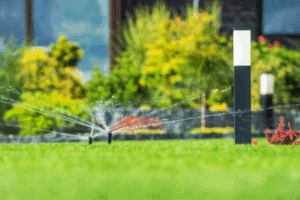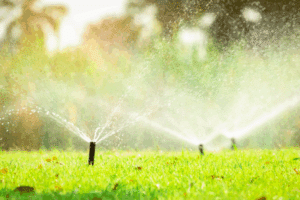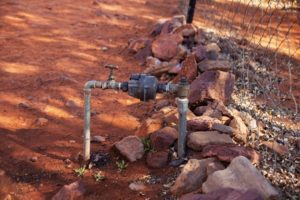Keeping your lawn green and healthy in Cleveland, Ohio, can sometimes feel like a challenge. You might be asking yourself: “How often should you run your sprinklers to give your grass just the right amount of water, not too much, and not too little? Overwatering wastes water and can damage your lawn, while underwatering leaves your grass dry and patchy. Finding the perfect watering schedule is key to a lush yard without wasting water or racking up high bills.
In this post, we’ll break down exactly how often you should run your sprinklers based on Cleveland’s unique weather, your lawn’s needs, and the seasons. By the end, you’ll have simple, practical tips to keep your lawn healthy and thriving all year round.
Why Does Watering Frequency Matter in Cleveland?

Watering your lawn the right amount helps it grow strong roots and resist Cleveland’s hot, humid summers and cold winters. Too much water can cause mold, fungus, or even kill the grass. Too little water stresses your lawn and causes dry, brown spots. Because Cleveland has a mix of rainy springs and humid summers, watering too often or at the wrong times can harm your grass more than help.
That’s why knowing how often to run your sprinklers in Cleveland is about finding a balance, giving your lawn the water it needs without wasting resources or harming your yard.
How Often Should You Run Your Sprinklers in Cleveland?

Most Cleveland lawns need about 1 to 1.5 inches of water per week. Rather than watering daily, it’s best to water deeply 2 to 3 times per week during the active growing season. Here’s a quick breakdown:
Spring: 1 inch/week (split into 2 days)
Spring rains are common in Cleveland, so monitor natural rainfall before turning on your system.
Summer: 1–1.5 inches/week (split into 2–3 days)
Hot, humid days and occasional dry spells mean your lawn may need more frequent watering.
Fall: 0.5–1 inch/week (1 day usually sufficient)
Cooler temps and reduced evaporation mean your lawn needs less water to stay healthy.
Winter: Rarely needed (unless dry and no snow cover)
Most lawns go dormant, but during an unusually dry winter, an occasional light watering might help.
Watering early in the morning is most efficient and healthiest for your lawn.
Signs Your Lawn Needs Water in Cleveland, Ohio

Cleveland’s changing weather can make it tricky to know when your lawn is thirsty. Look for these signs:
- Grass blades turning dull or gray-green: Your lawn is telling you it needs water.
- Footprints or tire marks stay visible: When you step or drive on the grass and it doesn’t spring back, it’s a sign of stress.
- Dry soil 1–2 inches below the surface: Check by poking a screwdriver or trowel into the soil. Some types of soil hold moisture longer than others, which affects how quickly your lawn dries out.
- Brown or patchy spots appear: Often caused by heat stress or drought.
- Wilting or curling grass blades: The grass is conserving water and needs a soak.
Keep an eye out for overwatering, too soggy soil, puddles, or a musty smell means you should cut back, especially since Cleveland’s rainy springs can easily cause this.
How to Measure Watering Amounts for Your Cleveland Lawn

Most lawns in Cleveland need about 1 to 1.5 inches of water per week during the growing season. Check out the average water usage for sprinkler systems to better plan your schedule.
- Place several empty tuna cans or shallow containers around your lawn.
- Run your sprinkler system for 15 or 30 minutes.
- Measure the water depth in each can with a ruler and calculate the average.
- If you collect 0.25 inches in 15 minutes, you’ll want to run your sprinklers about 60 minutes weekly to deliver 1 inch of water.
This simple trick helps you avoid overwatering, save water, and keep your lawn healthy.
Seasonal Watering Guide
Cleveland’s climate means your watering schedule should change throughout the year:
- Spring (March – May): Water about 1 inch per week, 2 times per week. Watch for rain since Cleveland springs are often wet. Water deeply to help roots grow strong.
- Summer (June – August): Water 2 to 3 times per week, early in the morning to beat the heat and humidity. Adjust based on rain — Cleveland summers can have dry spells and storms.
- Fall (September – November): Reduce watering to about once a week. Water deeply to prepare your lawn for winter dormancy.
- Winter (December – February): Usually, no watering is needed as the ground freezes or snow covers your lawn. If it’s a dry winter without snow, occasional watering may help, but this is rare in Cleveland
Watering Techniques and Timing for Cleveland Lawns
To get the best results from your sprinkler system in Cleveland:
- Water early in the morning, between 5 a.m. and 9 a.m.: This reduces evaporation and helps your lawn absorb water before the day heats up.
- Avoid watering in the evening: Wet grass overnight in Cleveland’s humid climate can encourage fungus and diseases.
- Water deeply and less often: Aim for about 20-30 minutes per session to encourage deep root growth. This makes your lawn more drought-resistant.
- Check sprinkler coverage: Make sure your sprinklers water your lawn, not sidewalks or driveways, to save water.
- Consider a smart sprinkler system: These systems adjust watering schedules based on Cleveland’s weather forecasts, rainfall, and humidity, saving water and keeping your lawn healthy.
Conclusion
Knowing how often to run your sprinklers in Cleveland, Ohio, can make a big difference in keeping your lawn healthy and green without wasting water. By adjusting your schedule with the seasons, watching for signs of over- or underwatering, and watering early in the morning, you’ll support stronger roots and a more resilient yard.
If you’re unsure or want to make sure everything’s running smoothly, consider reaching out for a professional sprinkler system service to help optimize your watering and keep your lawn looking its best.
